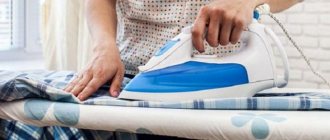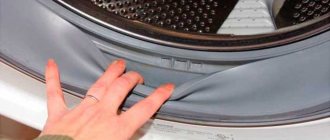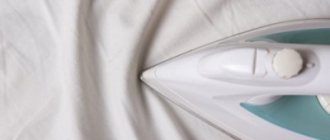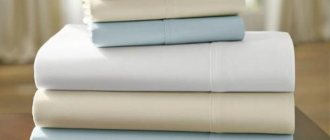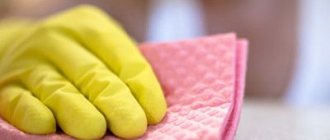With the birth of a child, a woman, in addition to joy, is faced with a lot of worries. And here you need talent to correctly prioritize.
In addition, it is necessary to have knowledge on optimizing the process of household chores. Perhaps some of them are completely useless? For example, ironing children's clothes.
Is it necessary to iron baby clothes after washing on both sides? Is it necessary to do this for newborns and for how long? You will find answers to questions in the article.
Points for and against"
Today, there is no consensus among medical professionals regarding the need to iron children's clothes. Old-school pediatricians actively recommend that young mothers carefully iron their clothes.
The opinion is justified by the fact that:
- harmful microbes are destroyed;
- Residues of detergent are removed;
- the fabric and seams on clothes become softer;
- the service life of things increases;
- the need for beauty and neatness is satisfied.
No scientific research has been conducted on these items, and the benefits of ironing are rather questionable . For each of the arguments, you can give a counterargument, and more than one.
Undoubtedly, with the arrival of a newborn, the physical load on a tired mother increases significantly. In maternity hospitals, diapers and clothes for newborns are not subjected to heat treatment after washing.
Modern pediatricians say that ironing children's things is possible, but not at all necessary.
The arguments against ironing are that:
The baby does not need sterile conditions, so if possible, the newborn is immediately placed next to the mother and discharged from the hospital within 2–3 days. In this case, the baby is populated by the microflora of loved ones and the home environment. This tactic contributes to the normal formation of the child’s immunity.- Children under 1–1.6 years old relieve themselves in diapers, then in their pants, and soil their blouses. If you do not use diapers, then a huge amount of laundry will accumulate during the day, which is difficult to process.
- If you use special detergents for washing children's clothes and rinse thoroughly, then there is no need for ironing.
Doctors advise ironing clothes from the inside without fanaticism in the following cases:
- until the umbilical wound has healed;
- if there are inflammatory processes on the navel or skin.
New items purchased for a baby must be washed and ironed before use. In the future, the ironing procedure is carried out if possible and desired.
Is it necessary to iron things for a newborn - the opinion of a neonatologist in this video:
Why you shouldn't iron clothes after washing
Despite the fact that after ironing the linen becomes aesthetically pleasing and safe, not everyone agrees to carry out such actions every time. If you are not looking for perfect cleanliness and a beautiful interior, you don’t have to use an iron. It is enough to hang things correctly after washing so that there are fewer wrinkles on them.
It is believed that when exposed to high temperatures, fabric fibers are destroyed . If you wash things several times and iron them, the laundry will take on a faded tint.
The colors will gradually lose their pigmentation. After just a few months, the linen will no longer be suitable for use and will have to be replaced.
Regular ironing causes the fabric to stop absorbing liquids. Hygroscopic properties are lost.
This is especially noticeable in the summer, when after sleep you have to dry your clothes, because they have not absorbed sweat. Not all materials are suitable for regular ironing.
Silk, jacquard and boiled cotton products wrinkle badly. To maintain their structure and maintain neatness, you can hang the laundry evenly on the dryer.
The main thing is that it should not be exposed to direct sunlight. If you use fabric softener during the washing process, do not use the iron. It is better to choose a steamer or steam generator.
The iron will “eat up” the aroma, and the laundry will not seem so fresh.
Up to what age and why?
From a medical point of view, ironing baby clothes can be justified until the navel has completely healed, that is, until the age of 2–4 weeks. However, if you properly care for the wound, wrinkled clothing does not pose any danger to it.
Women's practical experiences demonstrate diversity to the extreme. For example:
- careful ironing of children's clothes throughout their lives;
- until the baby is 1–3 months old;
- up to six months, a year, 2–3 years;
- exclusively for “exit”;
- They don't iron at all.
How many families, so many options. In this matter, every woman has the right to her own position. The only unanimity noted is that going for a walk, going to the clinic, or seeing guests necessarily requires ironing clothes.
Clothes dryer
Use ice
It's surprising, and maybe even strange for some, but in order to keep things smooth and fresh, you can use just ordinary ice. To do this, before hanging them in the dryer, place a piece of ice in your pocket or nearby.
During the drying process, it will melt due to temperature and then turn into steam, doing the same job as an iron, but with much less effort on your part. You can just as easily use a damp sock or lightly spray the item with water.
Measure out your laundry detergent carefully
If you want to end up with a fresh item that doesn’t need ironing as a result, “approximately” is not for you. In addition to the fact that it is really important to buy the washing powder that suits your washing machine in all respects, it is also important to use it exactly in the quantity that a certain washing mode requires, or that the container built into the machine allows.
This will provide you with clean clothes without unnecessary accumulations of powder and without residue, and will also give you confidence that your clothes will dry quickly, easily and look fresh and smooth without the use of an iron.
How to do it correctly, safely and comfortably?
If for some reason there is a need for regular ironing of children's clothes, then it makes sense to make this labor-intensive process more comfortable and enjoyable:
- Buy good equipment for the job. An iron with a steam generator function, an automatic temperature control system and a high-quality ironing board will reduce the time it takes to process products.
- If you have a regular iron in your arsenal, then you need to sort things by type of fabric and adjust the temperature for each pile.
Manufacturers attach a label to each type of clothing indicating the washing and ironing conditions.
To prevent the product from losing its appearance over time, you should not exceed the temperature limits for different fabrics:
linen — 1900–2000;- cotton — 1100–2000;
- wool — 1400–1650;
- natural silk — 1150–1400;
- viscose — 850–1150.
Knitted items are often present in a child’s wardrobe. This fabric loses its shape after washing and ironing, so this item is ironed from the inside out while slightly damp.
In this case, you do not need to actively move the iron, but gently apply it to the fabric. Children under 5 years old are not recommended to use synthetic items.
When do you need to iron?
In some situations, arguing over whether to iron clothes or not is not appropriate. The procedure is mandatory in the following cases:
- You have a newborn baby. Linen for children under 3 months of age should be ironed regularly. Young children have weak immune systems. If a child's skin comes into contact with pathogenic microorganisms found on underwear, this will provoke frequent illnesses.
- There are people in the house suffering from acute respiratory infections and colds. After using the iron, germs that can cause the spread of infections are destroyed. Laundry must be washed at a temperature of at least +90°C if it is made from natural fabrics.
- If someone in the house suffered from skin diseases of an infectious nature . If a person slept on bed linen, it must be thoroughly washed, ironed, and then treated with a steamer. If you don't have one, a regular iron with a steam setting will do.
- If there are bed mites, lice or bedbugs in the house. Using an iron will disinfect your laundry to reduce the parasite population.
- If you had guests who decided to stay overnight. They need to lay out clean and ironed linen so that you are not considered a bad housewife. Considering that you do not know what diseases a person has, you should then wash the clothes well and iron them.
There are alternatives!
In addition to various models of irons, the modern market offers high-tech mechanisms for quickly and efficiently putting things in order.
Along with the inventions of the century, there are simpler and more economical ways to iron clothes. Each of them has its own advantages and disadvantages.
The table shows alternative devices and methods of ironing without an iron:
| Name | pros | Minuses | How to use | Price |
| Steam generator |
|
| According to instructions | From 2 to 40 thousand rubles. depending on model and manufacturer |
| Steamer |
|
| According to instructions | From 1 to 10 thousand rubles. depending on model and manufacturer |
| Steam | Does not require financial costs | Long wait for results | Hang items over a bathtub of hot water for 20 minutes. Wait until dry. | For free |
| Hot mug |
| You may get burned. | Fill a metal mug with boiling water and iron the item. | For free |
| Special solution |
|
| Pour a mixture of equal parts of 9% vinegar, water and fabric softener into a spray bottle, spray on clothes, and let dry. | From 200 rub. |
| Wet towel | Economical |
| Carefully lay the item on a towel, wait until it straightens out, and hang it on a hanger. | For free |
| Wet hand | Economical | Suitable for minor uneven surfaces. | With a wet hand, run along the folds. | For free |
How to iron individual parts of things
Let's take a closer look at which parts of clothing are more difficult to iron, and talk about life hacks that you can use while working.
Shirt collar
How to tidy up your gate:
- Take out the frame bones.
- Spray the fabric with water from a spray bottle.
- Iron the collar from the wrong side, moving from the center to the edges.
- To ensure that the collar stands up, spray it on the inside with a starch solution and iron it again. This method is only suitable for light natural fabrics.
- Iron the collar from the front side.
Sleeves
It is better to iron the sleeves on a small ironing board, which is sold complete with a regular one. But if there is no special device at home, follow the recommendations:
- To ensure that there are no arrows left on the fabric after processing, first unbutton and smooth the cuff on both sides.
- Fold the sleeve along the seam and iron from the cuff to the shoulders.
- Unfold the sleeve so that the seam is at the bottom and in the middle and iron the sleeve, avoiding the fold lines.
Ironing wide sleeves and puff sleeves is more difficult than regular ones: they wrinkle more when washed, and they cannot always be laid out evenly on the board. To make things easier:
- Place a folded towel (preferably warm and damp) inside the sleeve. The flashlight will take shape and all wrinkles can be smoothed out.
- Steam the sleeve by weight using a regular iron or steam generator.
- Wet the sleeve a little and blow hot air from a hair dryer on it - the damp fabric will straighten out under its own weight.
Embroidery
When ironing embroidery and other types of decor, follow the rules:
- You can iron the design only from the wrong side. If this is not possible, iron the embroidery through a damp cloth, gauze or special mesh.
- To prevent the threads from becoming wrinkled and the design to retain its volume, iron things hanging or on a soft surface, for example, a terry towel.
- It is better to steam and hang embroidery with beads.
What happens if you don't iron it on both sides?
During the period of caring for an infant baby, it is dangerous for a mother to overload herself with unnecessary work . Postpartum recovery, hormonal changes, daily household chores - all this contributes to the accumulation of excessive fatigue.
If the child is healthy and developing well, there is no need to carefully iron the linen, especially on both sides.
And if you use modern technology, ironing can be a pleasure. Knowing the basic rules for washing and drying things will help you completely forget about ironing.
The only disadvantage of refusing to iron children's clothes is possible condemnation from relatives, loved ones, and friends. Some mothers find it difficult to bear this moment.
Doctor Komarovsky's opinion
A well-known pediatrician believes that for a small child it is much more important to have happy parents than perfectly ironed clothes.
To save mom from countless washings and ironing, you need to use modern inventions, namely: a diaper.
According to the doctor, washing children's clothes must be done using special means. Rinsing should be done in 2-3 cycles .
The issue of ironing clothes is strictly individual, the main thing is not to the detriment of family relationships.
Doctor Komarovsky’s opinion on washing children’s clothes in the video:
Tips for removing wrinkles from suits
Useful: it is recommended to iron suits through a damp cotton cloth.
It is preferable to start ironing such products from the sleeves, first processing the lining. To do this, by the way, you should take a small board (the kind used for ironing shirts). Then we begin to iron the hems and top of the jacket, moving from one edge to the other. After that, move on to the collar, back and lining. Finally, smooth out the edges.
However, if you are afraid to use an iron, you can get rid of wrinkles from your jacket using another method: hang the product over a bathtub filled with water and smooth out the “wrinkles” with your hands. A couple of hours after this “steam bath” all the wrinkles will go away.
Unfortunately, trousers will have to be ironed much more often than the top of a suit. And all because the trousers lose their appearance as a result of long wear, the front folds “go away”. Iron the pants from the wrong side - first you need to process the pockets and seams. Work on each pant leg separately, moving from bottom to top. If you want to preserve the hands longer, wipe them on the inside with dry soap, and iron them on top through gauze, moistening it in a vinegar solution.
Tips and prohibitions
To keep your child’s clothes and linen neat and last a long time, you need to know some tricks . Among them:
- It is not advisable to iron terry products, they become rough and do not absorb moisture well;
Do not heat-treat clothes with stains, as they will be difficult to remove;- you cannot pull the thing;
- First, iron small parts of clothing (collars, cuffs, sleeves);
- items made of dark fabric are ironed from the inside out;
- the product is first processed across and then lengthwise;
- prolonged heat exposure on the fabric will make it rough;
- do not overdry things; if this happens, you need to iron them with steam or spray them with water;
- After ironing, the laundry should cool for 1–2 hours on the board, and only then put it in the closet, so the clothes retain their shape longer.
Ironing
Sort your clothes
One of the most important factors in keeping your clothes smooth with your dryer is the right temperature. Some items dry at higher temperatures, while others require much lower degrees, so separating them would be a great idea. It depends on the fabric the garment is made from and the style.
The best way to find out at what temperature it is better to dry a particular item, so as not to bother with ironing later, is to read the information on the label.
Use a hanger
It's no secret that hangers and hangers are one of the best and least expensive means for ideally storing clothes. By using them, you will prevent your clothes from creasing and you will not need to iron the item every time before going out.
Even a slightly ironed item will look fresh and neat after being stored on a hanger, and not somewhere on a shelf or in a drawer.
